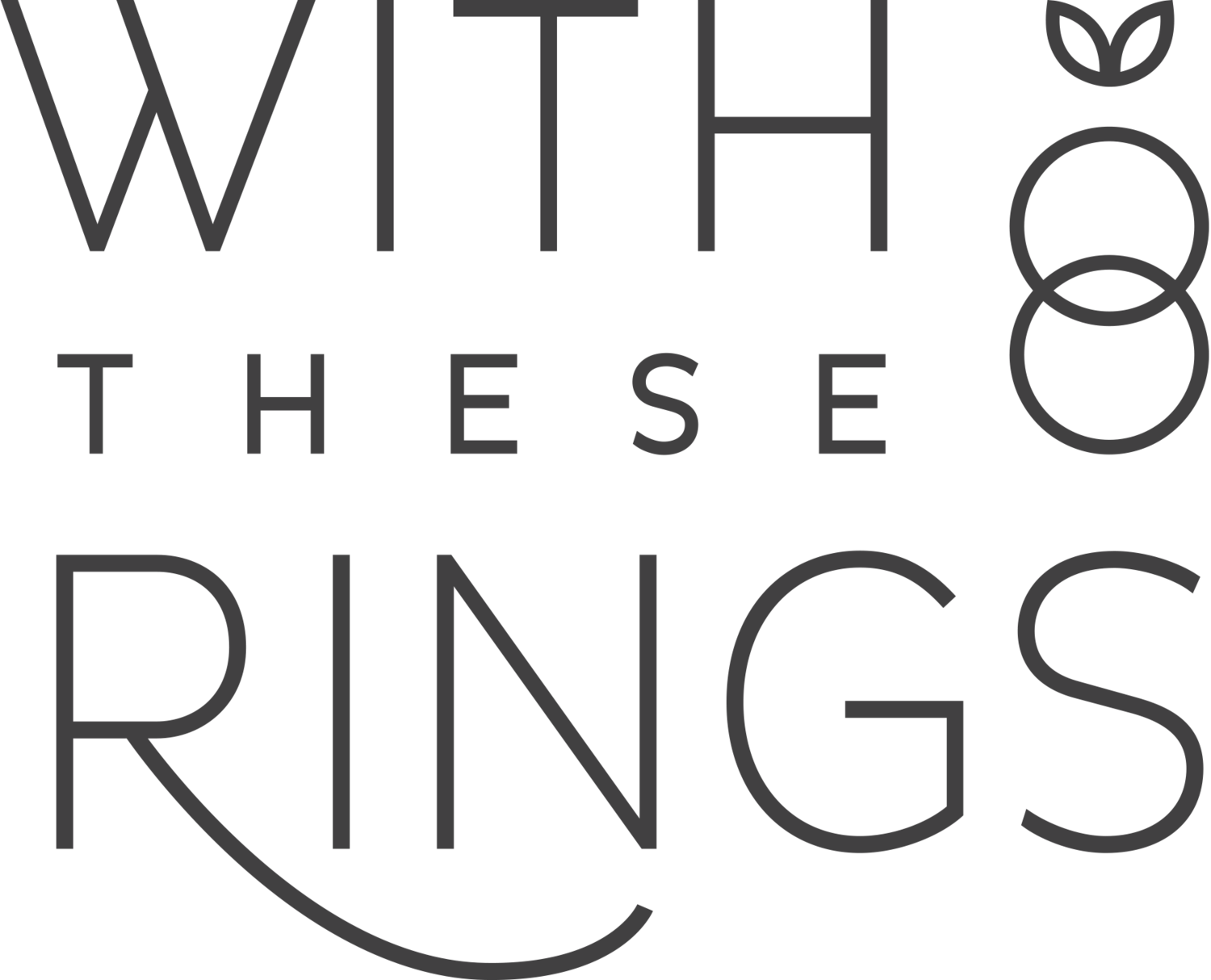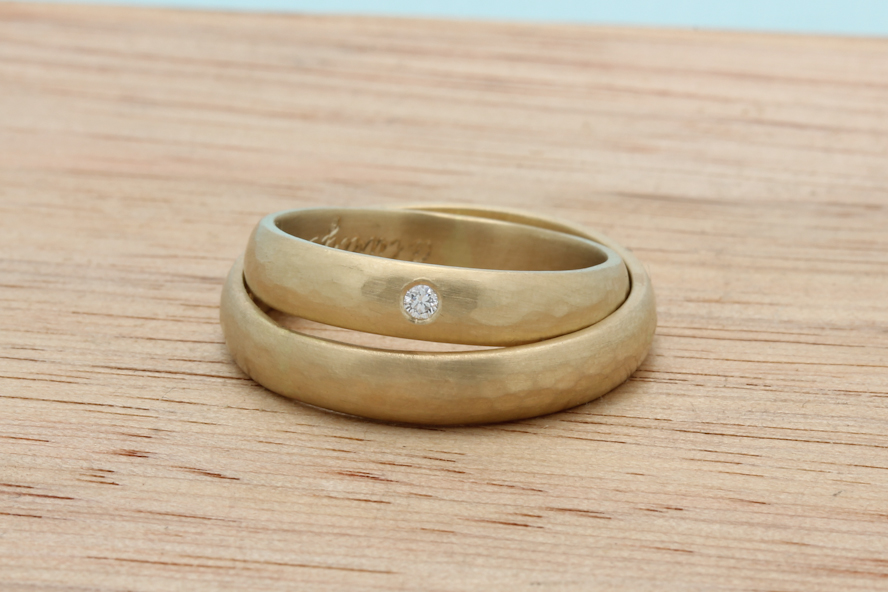Rings, no matter the karat or type of precious metal, will show age with daily wear. As we go about our day-to-day lives, our rings will inevitably collect scratches, marks, and in some cases a myriad of buildup. (lotion, dirt, makeup, ect.)
Everyone’s rings will wear at a different rate depending on your lifestyle, but all rings will show wear over time. I personally like the way that rings age to show the years that we have been together. But some people want to keep their rings looking new for as long as possible. Wear is inevitable but luckily, there are simple and inexpensive solutions to care for your rings and freshen up their finish.
Issue 1: Burnish marks
These are the most common marks on a ring and are actually just on the surface of the metal. Whenever precious metals rub against something harder than themselves it will leave behind a mark. Usually these burnish marks or scuffs are most noticeable as they first start to appear, especially on wide bands. But as your ring becomes covered in these marks it will create a nice consistent finish. Over time brushed/matte finishes will start to look more shiny, while polished finishes will start to look a little more dull. Some metals are more durable than others, but this process is bound to happen on all precious metals rings. How quickly it happens really depends on how hard you are on your jewelry. Restoring the surface finish is an easy task with the right supplies and steps that are listed below.
What to Do: Touch up the Finish
Some people embrace the new finish that emerges once the burnish marks consistently cover the surface of the band. Other people like to touch up the finish of their ring. Please note that both a brushed and polished finish is created by putting micro-scratches in to the metal, which means that you are removing a microscopic amount of metal each time. Even though it is only scratching the surface it will slowly add up over time so try not to go too overboard here.
Brushed Finish
If your band has a brushed finish, take a new, clean scotch bright pad to touch up your ring’s finish. Rub the pad around the surface of the ring in the pattern that you like. Scotch bright pads can be found at hardware stores, you can even use the rough side of an unused sponge. Some cleaners can be abrasive and impact the finish which is why you want to be sure that the sponge is unused.
Polished Finish
For rings with a polished finishes, I recommend a sunshine polishing cloth. They are embedded with a polishing compound that will bring shine back to your ring, make sure to use good pressure so the compound is activated. After you are finished be sure to clean your ring using a warm water and mild soap like Dawn.
Issue 2: Scratches and Dings
These are marks that go below the surface of a ring, either denting or gouging the metal. Scratches are caused by more aggressive impact with a material that is harder than your ring. Picture activities such as rock climbing, weightlifting, or working with steel tools. These can be buffed out by a jeweler* but doing so will remove a small amount of metal from around your ring. Because of this you would only want to do it occasionally. Some precious metals are more prone to scratches than others. Be sure to take some time to read about the different types of gold and the pros and cons of silver to help you pick the best metal for your rings.
*An extra note if you have a palladium white gold ring. White gold rings made in my workshop are not rhodium plated. If you take your ring to a jeweler other than me to be repaired, resized, or buffed, make sure to let them know that you DO NOT want the ring to be plated. It is standard practice to rhodium plate white gold to give it a bright white color. So if you like the look of your palladium white gold ring be sure to let the jeweler know or your ring will return looking different in color.
Issue 3: Residue vs. Tarnish
Residue can build up on your rings from soap, lotion and even dead skin. Residue is mostly an issue under stones and in deep texture or engravings. This is easy to fix with a basic cleaning. Tarnishing is a chemical reaction that most commonly happens between metal and oxygen (or other compounds) A thin, dark layer will form on the surface of the metal. Gold does not tarnish, but silver alloys will. It is not common for wedding rings to tarnish since since they are almost always on your finger and daily wear doesn’t allow the tarnish to build up. It is most likely to occur in valleys of the surface. If you leave your silver ring off for a period of time it can start to tarnish. It is also interesting to note that some people have a body chemistry that causes silver to oxidize and other people’s chemistry acts as a polish. If you find that your silver ring has tarnished start with a basic cleaning and then, if needed, you can touch up the finish (directions above)
What to Do: A Basic Cleaning
Cleaning Simple Bands
To remove residue on your ring from anything from lotion to dirt you can soak it in warm water and mild soap. Many jewelers swear by Dawn since it works well to remove oils left behind from our skin and lotions. After soaking rinse well and dry with a soft cloth. I usually just use a cotton t-shirt.
Cleaning Rings with Stones, Textures, or Engravings
If your ring has stone settings or a prominent texture you can use a new, soft toothbrush with either just warm water or water with mild soap for a little extra cleaning. There are also special jewelry cleaners, just be sure to read the recommend uses. Never use abrasive cleaners on your jewelry since it can leave marks on your metal or softer stones. This includes a used toothbrush since many toothpastes have abrasive ingredients.
Some people choose to buy a small ultrasonic cleaner to keep their stones looking bright and sparkly, but please be sure that it is safe for the type of stone in your ring.
prongs & Settings
Most couples already have their engagement rings by the time we meet. But, no matter where you got your ring from or how long you’ve had it, if you have a prong setting you should make a habit of checking your prongs and occasionally having them checked by a jeweler. (It doesn’t necessarily have to be the jeweler where you got your ring from.) Many people think that a ring made of metal it will never change, but that is not the case. Similar to a other natural materials like a wooden table or leather shoes, jewelry will hold up better over time with a little maintenance.
Losing a stone is scary, so most people want to avoid thinking about it all together. But prevention is key! Precious metals wear and change with time and if your prong is a little off there is the potential of losing your stone. Usually this happens little by little. So if you keep an eye on your ring you will likely catch it before it is an issue.
Here are things to check for:
If you notice that your ring snags often on sweaters or blankets, it could mean that a prong is slightly off causing some space for threads to get stuck between the stone and the metal. Usually this becomes an issue slowly, slowly, then very quickly. This is because the of the cycle: the more it bends the more it snags and then the more it snags the more it bends, causing it to open.
If you shake your ring or gently tap on the stone can you hear it clicking? Do you see any movement? Can you twist or move your stone at all if you gently try with your fingernail? Don’t force any of the tests, keep it gentle. You don’t want to loosen your stone by overdoing it!
Run your finger over your prongs. Do they feel nice and round at the end or flat and worn?
Most prongs are designed to be evenly spaced. Keep an eye on them to make sure they look the same and don’t shift over time. Think about the spacing of numbers on a clock, that spacing should stay the same.
The more delicate the setting, the more likely a prong is to bend. (At With These Rings we almost always work with heavier weight prongs.) Many ring wearers go their whole life without having a problem, but that is not a reason not to check yours! It is ideal to take your ring to a jeweler who specializes in fine jewelry repairs in the case of a prong that is badly damaged.
Important setting note! If the setting catches and there is a lot of force/weigh, in some cases the entire setting itself can bend. The larger the stone the more the setting becomes a leverage point. Bending is more likely with a larger setting on a pavé set band, due metal being removed where the stones are placed. These rings can take most normal daily. Just keep in mind that no precious metal ring is indestructible, no matter how well it is made. So be mindful of how your treat your setting.
Many large scale jewelry companies do have warranties, this usually requires that you keep up with their maintenance schedule. If you did not pick out your ring be sure to talk to your partner about what the jeweler said. Most home owners and rental insurance plans have options to cover jewelry. I recommend Jewelers Mutual as a great jewelry insurance option. They cover “preventive repairs, including prong retipping, broken, worn or bent prongs, broken earring posts, clasp replacement, restringing of broken or stretched pearl strands, and stone tightening” But remember, you have to have it checked to know that you need those preventive measures.





